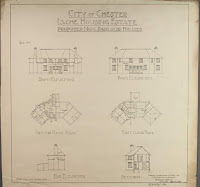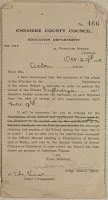It is one hundred years
since an Act of Parliament transformed housing in the UK. There was a significant housing shortage at
the end of 1918 - 600,000 homes were needed in England and Wales alone - and many
soldiers returning from the First World War were having to share accommodation
or live in poor conditions. Prime
Minister David Lloyd George promised “habitations fit for the heroes who
have won the war” – which became the slogan ‘Homes fit for Heroes’ in the general election he called the day
after the 1918 Armistice.
The government
based their post-war housing policy on a report of a committee chaired by MP
(and architect) Sir John Tudor Walters, set up to consider ‘Provision of Dwellings
for the Working Classes’. It included recommendations
on minimum standards in the design of houses and the layout of housing estates –
low-density garden suburbs, rather than the overcrowded narrow terraces of the
past - and formed the basis of the 1919 Housing and Town Planning Act. This became known as the Addison Act, after Dr
Christopher Addison MP, who was influential in its creation and implementation
as Minister of Health.
The Addison Act was
ground-breaking because it made housing a national responsibility for the first
time, recognising that private companies would not be able to provide the
quantity or quality of homes needed for working people at affordable rents. It promised Government subsidies to help
construct half a million houses within three years. Providing uncrowded,
well-build homes on secure tenancies at reasonable rents to primarily working class
people represented a significant change in social policy and to the future
lives of these people.
As the economy
grew weaker in the 1920s, cuts had to be made and fewer than half of the
planned homes were completed under the provisions of the Addison Act. However further housing legislation through
the 1920s and beyond extended the duties of local councils to make social housing
(‘subsidy houses’) available – initially using land acquired following the
Addison Act - and under the provisions of the inter-war Housing Acts, local
councils built 1.1 million homes.
Cheshire
Archives and Local Studies hold a wide range of records relating to council
housing, from the earliest houses outlined in the Addison Act. Our collections include large numbers of
plans and correspondence relating to the construction of council houses across
the county, minutes of Housing Committees dealing with construction and
management, records related to slum-clearance that took place nationally following
the 1930 Housing Act, and Local Studies publications and images which can be
viewed on the Cheshire Image Bank.
Addison housing is mentioned by name in the minutes of Crewe Borough
Council’s Housing Committee (document reference: LBCr 2407/10/2). The images below, taken from a meeting in
August 1925, refer to a report on contracts for Addison housing. The minutes record details such as the
builders doing the construction and the costs of the work, and also give an
insight into the people who would be living in the new houses. Their circumstances were typical of those the
Addison Act was designed for: of 36 new tenants, ten were labourers and five
worked on the railway as porters, goods porters, shunters or firemen. Three were listed as shift foremen, and other
professions included a machinist, blacksmith, motor driver and postman. All the tenants had families, ranging from
two to seven children, and for five of them, “an addition to the family is
stated to be expected shortly”. Almost
60% of this group (21 out of 36) were ex-servicemen, and all but one family
were living in lodgings or with parents.
For three of the prospective tenants, the men’s wives and families were
living separately in other towns.
Having
been granted an affordable Addison house, there was an expectation the tenants
should look after them – and it seems this included the garden. The image below shows the minutes of a
Committee meeting that took place on the Gresty Road Housing Site in Crewe where
members viewed “with considerable distress” the state of some tenants’
gardens, and privet hedges that were “not properly trimmed”. They resolved to send tenants a strongly
worded letter – unless their gardens were properly cultivated, the Committee
would “seriously consider”
terminating their tenancy!
Further north
east in Cheshire, the records of Macclesfield Rural District Council show the
varying levels of rent paid by tenants for different types of houses. In its Register of Houses Provided by the
Local Authority (ref: LRM 4993) two columns show the “appropriate normal
rent per week” and a lower “rent charged per week” – for example
what could have cost ten shillings and sixpence in rent per week for a three
bedroom parlour house cost eight shillings and sixpence for council tenants.
As for the construction of the houses, Cheshire
Archives holds building plans and associated correspondence from across the
county. Addison houses were divided into
five main designs, known as Types A to E, although individual councils were permitted
to adapt them. The simplest had a living
room where most of the cooking would be done and scullery where you would wash,
others would have most of the cooking done in the scullery but had a separate
bathroom, and the most luxurious had an upstairs bathroom. A superior version of each type would have an
additional parlour - around 40% of immediate post-war local authority homes had
them. Most Addison houses had three
bedrooms – only 15% did not, in contrast with 60% of pre-war houses that had
only two bedrooms – and all had indoor toilets and covered coal stores, which had
not been the norm in working class homes before.
This 1924 application for a subsidy house in Hungerford Road, Crewe (ref: LBCr 6492/57/43) is one of many bundles of contracts, correspondence and plans we hold for individual tenants. It is a three-bedroom parlour home.
And though they are almost
a hundred years old, these Runcorn Rural District Council plans and
blueprints for Type A houses in Frodsham Lordship are still bright and
clear. The technical drawings of external
elevations and internal floorplans clearly show the layout of the three-bedroom
non-parlour house, with living room and scullery. (ref: LRR 27/64 and LRR
27/30).




Designs for Type B and C houses are
illustrated by these plans from Lache in Chester. They date from 1931 but the designs include
both parlour and non-parlour semi-detached homes, and a short terrace, in a style
in-keeping with the Addison Act.
In terms of layout
of estates, local Council planners were clearly adhering to the standards
of the Tudor Walters report in their proposed housing in Helsby in 1929 (ref:
LRR 27/51). Spacing between and in front of houses, good-sized gardens and a
mixture of different styles of houses were used in the same area, to avoid the uniform
and overcrowded feel of working class homes of the past.
The Addison Act was the catalyst for an extensive
council house building programme one hundred years ago, but this important
housing continued to be provided after the 1920s, including in Cheshire. The building work mentioned above at the
Lache estate in Chester was not completed until after the Second World War, for
instance, and building started at Blacon, also in Chester, in 1946 and continued
until it was one of the largest council estates in Europe by the 1970s. At the end of that decade, a third of the
British population lived in social housing. What
began with the Addison Act and Homes Fit for Heroes had a lasting effect on
the lives of working class people and their families for most of the 20th
century.
All these
documents and more are available to view at Cheshire Record Office in Chester.


































